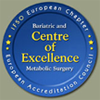Laparoscopic Surgery
What constitutes laparoscopic surgery

The Dr. Ballesta Laparoscopic Centerapplies laparoscopic surgery as a minimally invasive technique used in many operations previously performed only by open surgery.
This surgery permits operating without opening the individual, resulting in advantages to the patient's recovery.
To perform laparoscopic surgery, incisions of 3-10 mm are made to the skin where a mini video camera is inserted into the cavity where the operation will take place (abdomen, chest, etc.). Through these incisions and guided by the view afforded by the video camera, we introduce the necessary instruments (which act as substitutes for hands) to perform the operation.
Performing laparoscopic surgery requires not only extensive training, but sophisticated instruments as well. Laparoscopic surgical techniques are the same, known techniques used in open surgery, only with less aggressive methods.
After surgery, the instruments are removed and the incisions closed without leaving easily visible scars.
Given that surgery is done with a video camera, in many countries it is called video surgery and, as surgery is sometimes performed with lasers, it is known as laser surgery.
Advantages of Laparoscopic Surgery

Currently, there is a trend in medicine to be more conservative in treating the patient's condition. The evolution of surgery, and in particular, general and gastrointestinal surgery, there has been a tendency to practice less aggressive surgery with the same curative intent.
Laparoscopic surgery has come to be called minimally invasive surgery. With laparoscopic surgery, including obtaining all the benefits of conventional surgery, we respond to three expected premises of today's society:
• Optimal cosmetic results (scars of 3-12 mm).
• Minimum postoperative pain (absence of large wounds).
• Rapid patient recovery (usually a 24-48 hour postoperative stay).
The incisions, since they are so minimal, hardly carry a risk of infection. Because neither the abdomen nor the chest is opened, respiratory infections are rare. The end result is that the patient can be discharged within 24 to 48 hours postoperatively. As such, should all surgeons operate laparoscopically?
For the surgeon trained in open surgery, laparoscopic technique represents an added difficulty because one has to learn from scratch, and not everyone is sufficiently trained to successfully develop these new medical technologies. It requires a minimun training of five years or more.
In 1990, only 1 percent of surgeons performed laparoscopic surgery, in 2000, at least 30 percent of surgeons (especially younger ones) performed basic laparoscopic surgery (gallbladder); more complex surgeries (stomach, colon, etc.) are performed by only a few today.
Therefore it is significant that the Dr. Ballesta Laparoscopic Center is the only medical complex in Spain with this dedication to and philosophy about performing laparoscopic surgery.
What can be operated on through laparoscopic surgery

The first operations that were done by laparoscopic surgery consisted of gallbladder removal. This operation is very widespread today and is performed in the majority of centers.
Currently specially-trained teams are ready to develop a number of operations for laparoscopic surgery, those of which were previously performed through open surgery, such as gastro esophageal reflux and hiatal hernia, and surgeries of the colon, adrenal gland, and spleen, etc.
Diseases or conditions, which are treated by laparoscopic surgery with sufficient guarantees of success, depend mainly on the surgical team's experience and years of training, and its subsequent dedication to the practice.
In the list of diseases that we treat at the Dr. Ballesta Laparoscopic Center, you can search by organ or system the various diseases that we treat with laparoscopic surgery.
Laparoscopic surgery is especially recommended for obesity surgery and emergencies.

